64.1 Using the Administration Web Console
Some aspects of the Calendar Publishing Host can be configured using the Administration Web console.
64.1.1 Logging In to the Administration Web Console
The Calendar Publishing Host Administration Web console is a browser-based administration tool that enables you to easily change the configuration of the Calendar Publishing Host.
-
Display the Calendar Publishing Host Administration Web console login page:
http://network_address/gwcal/admin
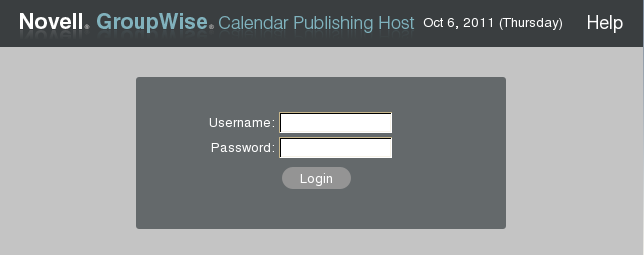
-
Provide the administrative user and password you set up in
Setting Up a Calendar Publishing Host
in the GroupWise 2012 Installation Guide, then click .
64.1.2 Changing Post Office Settings
-
Log in to the Calendar Publishing Host Administration Web console.
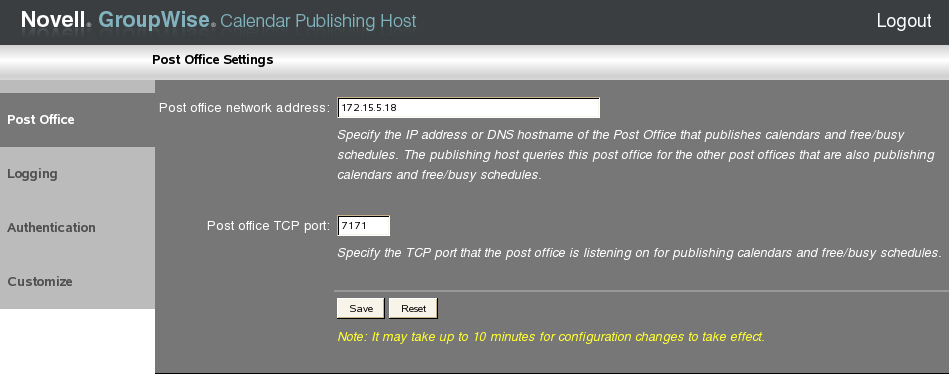
The Post Office page provides the information that the Calendar Publishing Host needs in order to communicate with a POA to obtain calendar and free/busy information. The initial information was provided during installation, as described in
Configuring a POA for Calendar Publishing
inInstalling the GroupWise Calendar Publishing Host
in the GroupWise 2012 Installation Guide. -
Change the post office settings as needed.
Post office network address: Specify the IP address or DNS hostname of the POA that is configured for calendar publishing.
Post office TCP port: Specify the calendar publishing port that the POA uses to communicate with the Calendar Publishing Host.
-
If you make changes, click .
64.1.3 Adjusting Log Settings
-
Log in to the Calendar Publishing Host Administration Web console, then click to define log settings for the Calendar Publishing Host:
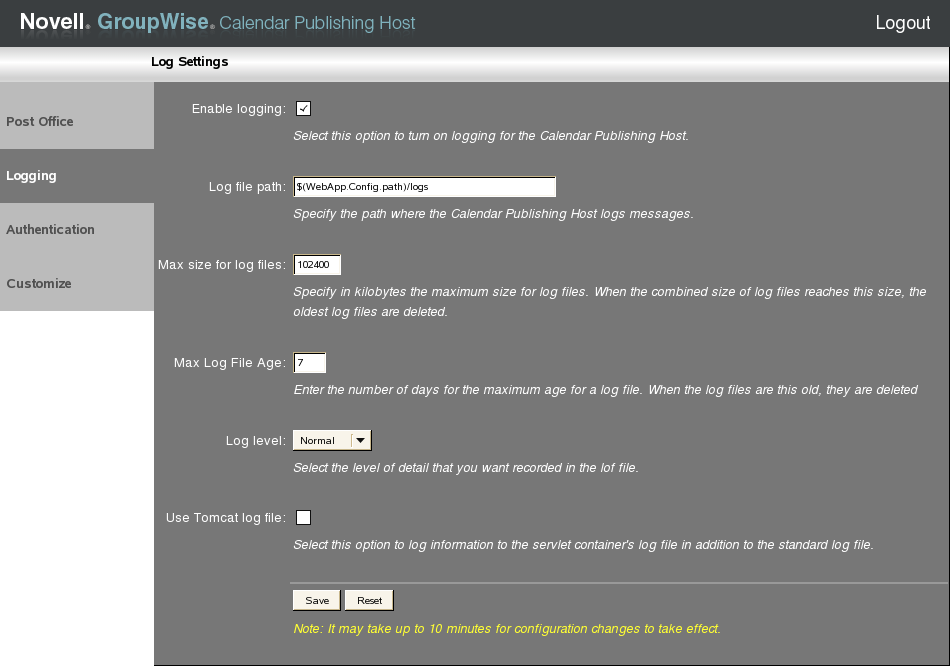
Logging is enabled by default. Default settings are provided for the rest of the fields.
-
Change the Calendar Publishing Host log settings as needed:
Enable Logging: Deselect this option to turn off Calendar Publishing Host logging.
Log File Path: The default log file location is the GroupWise Web application working directory.
Change the log file settings as needed:
Max Size for Log Files: Specify in kilobytes the maximum size for log files. When the combined size of log files reaches this size the oldest log files are deleted.
Max Log File Age: Specify the number of days for the maximum age for a log file. When a log file reaches this age, it is deleted.
Log Level: Select the level of detail that you want recorded in the log file.
Use Tomcat Log File: Select this option if you want the same information logged to the Tomcat log file as is logged to the Calendar Publish Host log file. The location of the Tomcat log file varies by platform:
OES 11:
OES 2 Linux:
SLES 11:
SLES 10:
Windows:
-
If you make changes, click .
64.1.4 Configuring LDAP Authentication
-
Log in to the Calendar Publishing Host Administration Web console, then click .
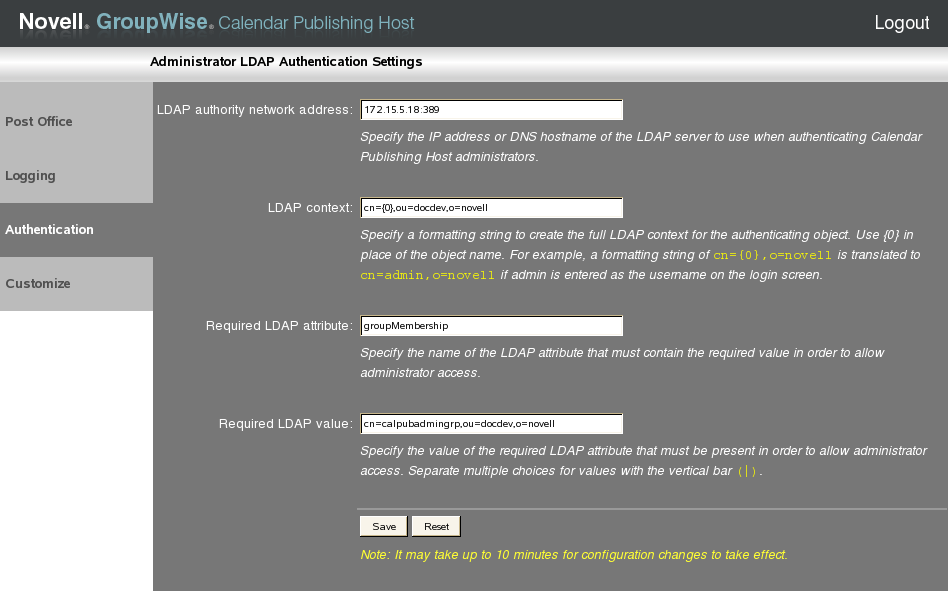
The Authentication page provides the information that the Calendar Publishing Host needs in order to log into eDirectory. The Calendar Publishing Host uses LDAP authentication to log in. The initial information was provided during installation, as described in
Setting Up Calendar Publishing Administration
inInstalling the GroupWise Calendar Publishing Host
in the GroupWise 2012 Installation Guide. -
Change the authentication information as needed:
LDAP Authority Network Address: Specify the IP address or DNS hostname of an LDAP server where users of the Calendar Publishing Host Administration Web console have accounts. Include the port number (typically 389 for non-secure connections and 636 for secure SSL connections).
LDAP Context. Specify the context in which the User objects for Calendar Publishing Host administrators are located. The variable {0} represents whatever user name is provided on the Administration Web console login page. The User object for the administrator must be located in the specified context. By providing the context here, administrators do not need to provide the context when they log in to the Administration Web console.
Required LDAP Attribute: By default, the Calendar Publishing Host checks users for membership in a specific group before it grants access to the Calendar Publishing Host Administration Web console. This default is typically appropriate.
Required LDAP Value: If you retain the default LDAP attribute of groupMembership, specify the full context of the group to which Calendar Publishing Host administrator users must belong in order to log in to the Administration Web console. If you change the default LDAP attribute, specify the required value for that attribute.
-
If you make changes, click .
The SSL trusted root certificate that you supplied when you installed the Calendar Publishing Host cannot be changed from the Administration Web console. If you need to change the certificate information, see Section 64.2.5, Changing the SSL Trusted Root Certificate.
64.1.5 Customizing the Calendar Publishing Host Logo
-
Log in to the Calendar Publishing Host Administration Web console, then click to modify the appearance of the main browser page displayed by the Calendar Publishing Host.
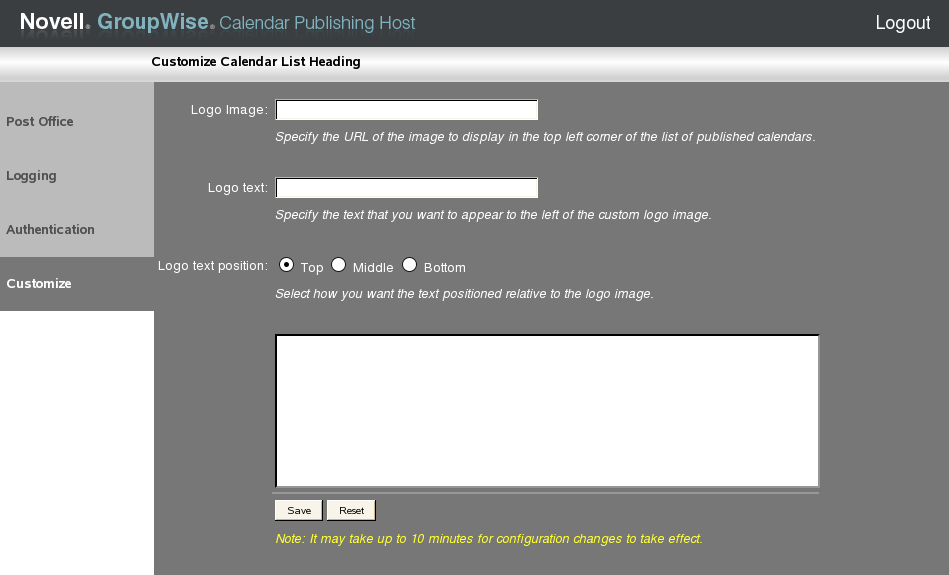
The Customize page enables you to use a different logo, perhaps your company logo, on the main Calendar Publishing Web page.
-
Provided the information for your company logo:
Logo Image: Specify the full path and file name of the customized image file.
Logo Text: Specify the text to accompany the customized image.
Logo Text Position: Select , , or , based on the example displayed in the box below the field.
-
Click .
64.1.6 Logging Out of the Administration Web Console
When you close the browser page, you are automatically logged out of the Calendar Publishing Host Web console.
The Calendar Publishing Host checks its configuration file (calhost.cfg) every 10 minutes. Therefore, it can take up to 10 minutes for the changes you made in the Administration Web console to take effect in the functionality of the Calendar Publishing Host.
Restarting Tomcat
If you want your changes to take effect immediately, restart Tomcat:
|
OES 11: |
rcnovell-tomcat6 stop rcnovell-tomcat6 start |
|
OES 2 Linux: |
rcnovell-tomcat5 stop rcnovell-tomcat5 start |
|
SLES 11: |
rctomcat6 stop rctomcat6 start |
|
SLES 10: |
rctomcat5 stop rctomcat5 start |
|
Windows: |
|